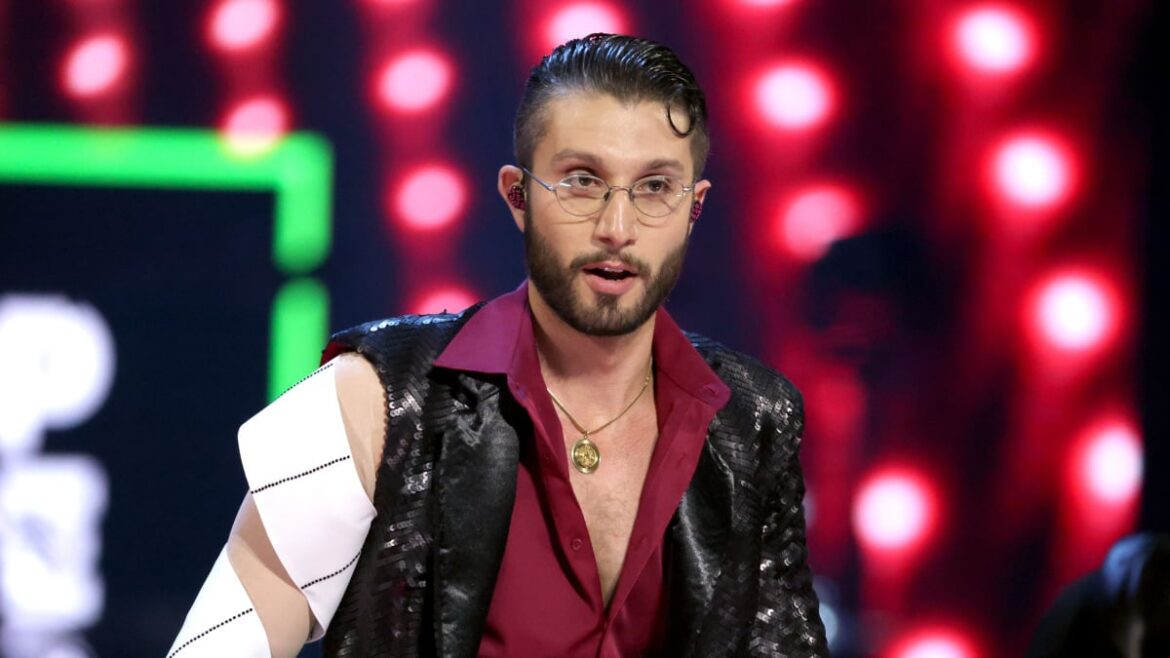When a fan recently posted on X, “bbno$ is my favorite rapper why does he have to be so mean to AI artists? 🥺🥺,” the Canadian musician didn’t offer a gentle explanation. Instead, he fired back with a simple, unambiguous response: “FUCK AI.”
This Tweet is currently unavailable. It might be loading or has been removed.
It’s the kind of blunt sincerity that defines bbno$ (pronounced “baby no money”) — the viral rapper known as much for his absurdist humor as his meticulous approach to independent artistry. But behind the all-caps expletive is a clear philosophy: In an era when algorithms can churn out songs, images, and videos faster than any human hand, he’s choosing to bet on people.
That choice is on full display in his recent video for “ADD,” a hyper-colorful, kinetic collage built entirely from fan-made animation. Instead of outsourcing to a studio or feeding prompts into generative software, bbno$ tapped over 20 independent artists — many of whom had already created fan art of him online — to bring the visual to life. The result is a whirlwind of distinct animation styles stitched together, each segment a small love letter from one creator to another.
“There’s two things to it,” he told Mashable at TwitchCon 2025, on the day of the release of his self-titled ninth studio album. “One, when people spend their whole life getting good at something, it kind of sucks when you can click a button and make something that’s more impactful. So I just wanted to give back to the community that’s shown me so much love.”
The other reason is even simpler: bbno$ feels better supporting people and human-made art. “It kind of makes me feel good when I’m supporting other artists, because I’m an artist too,” he explains. “I remember when I wasn’t making money — it’s such an exhilarating feeling when you finally can. So if I can help other artists get that, I want to.”
The “ADD” project took six months to complete, which is a herculean effort for a three-minute song. But the payoff was both a visual spectacle and a creative statement: proof that collaboration across 23 different minds, each bringing their own idiosyncrasies and artistic POVs, could create something no machine could replicate.
“I don’t know if I’ll ever get another piece of visual content that’s that stimulating ever again,” he admits. “Because it was 20 different people, twenty different minds.”
That kind of enthusiasm has long been part of bbno$’s appeal. His catalog, which spans goofy hits like “Lalala” with Y2K and more experimental cuts, thrives on a sense of human chaos that algorithms can’t quite fake. Even when he leans into internet virality, there’s a pulse of self-awareness. He’s in on the joke, but he’s also dead serious about the craft.
Mashable Trend Report
His distrust of AI isn’t rooted in fear of change so much as empathy for working artists. In an age when tech companies are pouring billions into AI music and video tools, and when artists’ work is being scraped to train those systems, bbno$ is thinking about the people behind the art.
“Massive organizations are starting to utilize AI and software to take people’s jobs away,” he says. “One of my best friends works at Amazon, and he was like, ‘I have a call with India. I’m presenting something that’s unfortunately going to take a lot of people’s jobs.’ He knows it sucks, but he also needs to make a living. That’s just where things are progressing. I’m just trying to do my part as much as I possibly can.”
It’s not a crusade against technology — bbno$ built his career on the internet, after all — but rather a push to preserve a kind of creative integrity that’s becoming increasingly endangered. These days, art is data, and he’s trying to keep the human part alive. “To keep people going, to keep the train on the other side,” he says, “you have to fund them. That’s the only way.”
There’s also a philosophical throughline here: bbno$ has always thrived on collaboration. His early success came from meme-driven partnerships with producers like Y2K and Diamond Pistols, and more recently, his output has ramped up to near-weekly releases that rely on a global web of creators, artists, editors, and fans. His entire career is a case study in the creative possibilities of the digital age, where art is built by people, not programs.
“I’ve never really been one to put a lot of effects in my videos,” he says. “If I do, it’s got to be something that took a year to make, not just something you plug in.” That ethos extends beyond visuals; it’s in the way he approaches songwriting, content creation, and even his signature humor. Everything feels a little rough around the edges, but that’s what makes it human.
The irony, of course, is that AI could easily imitate bbno$’s more surface-level quirks and offbeat flow, but it can’t replicate the sincerity that drives them. Creativity, for him, is an act of care.
On YouTube, the comments under “ADD” read like a digital roll call of collaboration. Fans and animators tagged their timestamps, celebrating each other’s work. “I animated 0:00–0:09! Everyone did such a fantastic job
Over on X, an animator named Kenzie shared a clip of bbno$ commissioning them for a project after they’d been “unemployed in the animation industry for two years because of AI.” The post has since racked up more than 350,000 likes — a glimpse at how deeply the gesture resonated.
This Tweet is currently unavailable. It might be loading or has been removed.
For a video that could’ve been made by a single generative model, “ADD” instead became a showcase of community. It’s the kind of messy, vibrant collaboration that only humans could pull off.
“I just wanted to give back,” he repeats. “That’s really it.”

